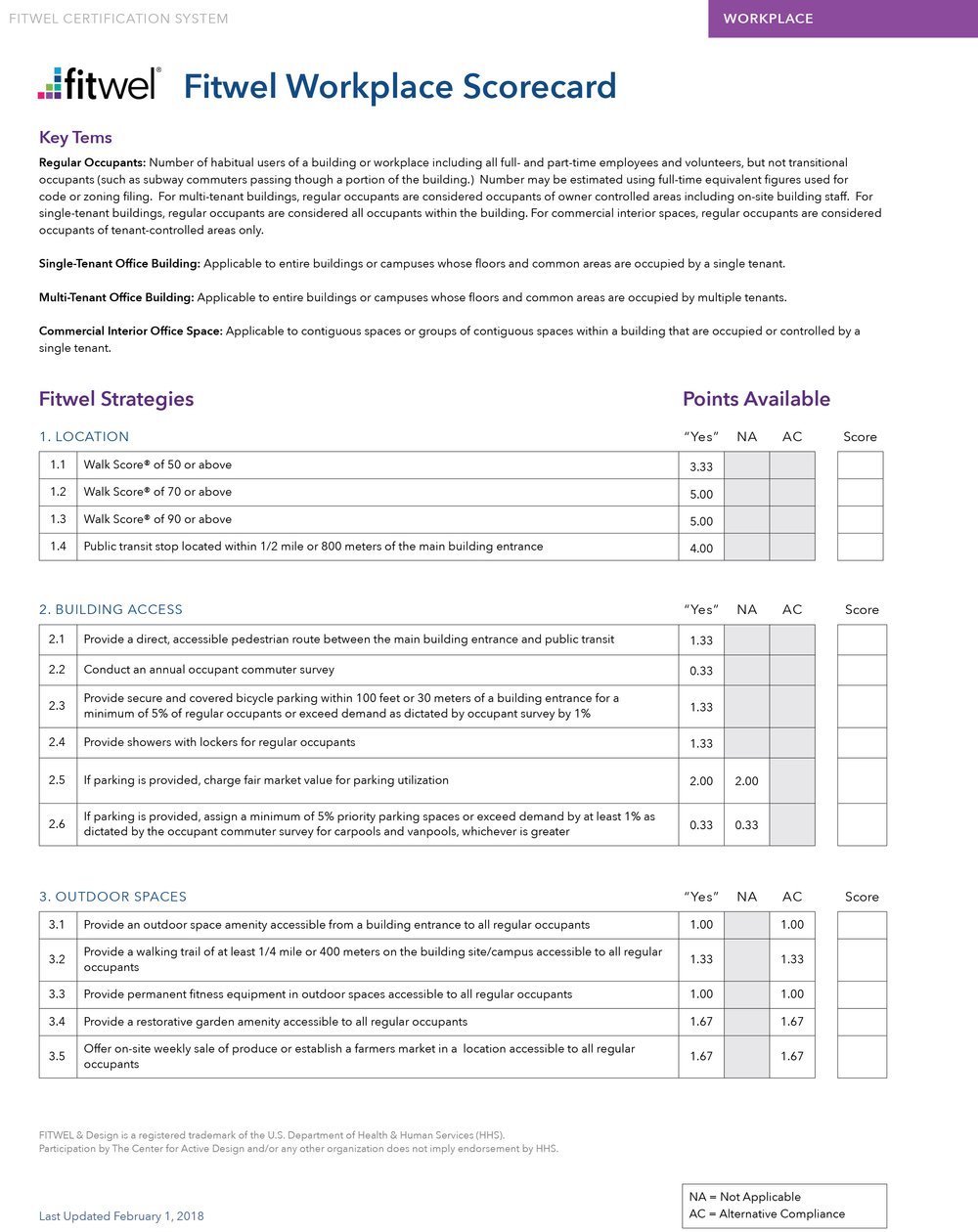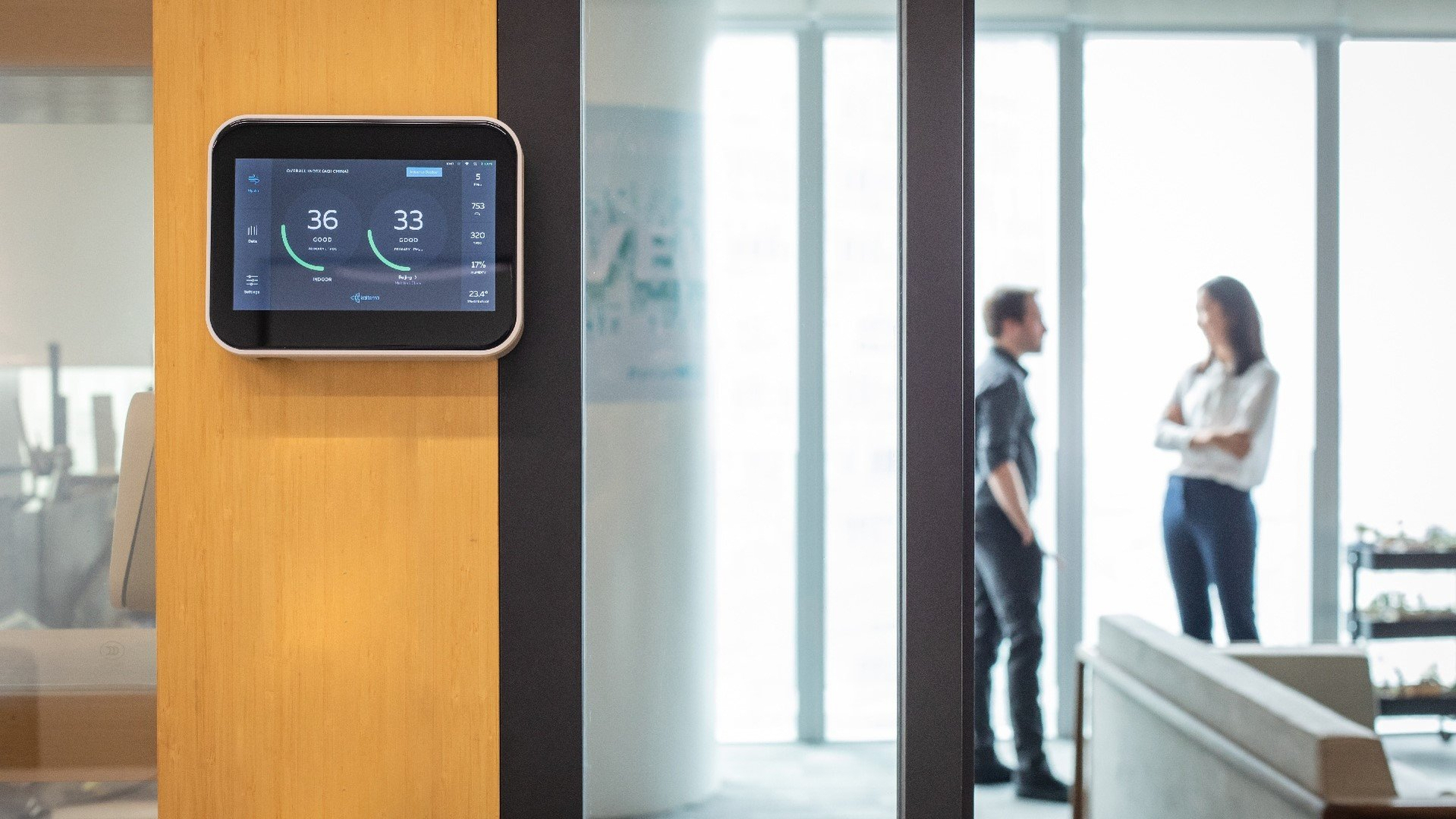Newsletter
Building certification programs have become a standard way for businesses to objectively measure and verify healthy improvements to buildings. The average American spends 93% of their life indoors, according to EPA figures - and growing awareness of the impact of indoor environments on health and wellbeing has led to widespread demand for healthy buildings. In recent years, Fitwel has become one of the main contenders in building certification, alongside programs such WELL, RESET, and LEED.
Working with the US government and covering all building types, Fitwel is one of the most flexible and affordable versions on offer. Let’s take an in-depth look at the features that make it unique.
What is Fitwel and Fitwel Certification?
Fitwel is a certification program that promotes and verifies building health. Developed by the General Services Administration (GSA) and US Centers for Disease Control and Prevention (CDC), the program was initially limited to federal buildings, but went universal in 2016. The government selected the Center for Active Design (CfAD) to administer the Fitwel system to non-federal buildings, and the certification now operates in over 35 countries.
Unlike most building standards, Fitwel covers almost all building types. Those seeking Fitwel certification will have their premises evaluated in several areas, after which they receive a scorecard and suggestions for improvements. Building owners receive revised scorecards when they make these improvements. There are three tiers of accreditation - the higher the score, the higher the tier.
How Fitwel Works
The Fitwel system requires your buildings to be evaluated across twelve areas. These include: building access, entrances and ground floor, stairwells, indoor environments, outdoor spaces, shared space, water supply, cafeterias and prepared food retain, vending machines, emergency procedures, and workspaces.
Once your building has been evaluated, Fitwel will send you a scorecard along with 63 strategies for improving your building’s health and Fitwel score. Once you incorporate these strategies, you can send evidence-based documentation back to Fitwel to boost your score. A score of 90 to 104 points is required for a single star rating; scores between 105 and 124 earn a two star rating, while the three star rating is reserved for scores of 125 to 144 points.
To illustrate, here is an example of scorecard that was used in a previous version of Fitwel (taken from the Fitwel website):

Fitwel has no prerequisites and does not necessitate on-site performance testing. All inspections examine documentation uploaded to an online portal designed for ease of use. The full journey from application to accreditation usually takes about twelve weeks.
What Makes Fitwel Unique?
Although Fitwel provides a building certification service similar to that of WELL or LEED, the company occupies a niche in the industry. Let’s take a closer look at some of the reasons for this:
Affordability
One of the biggest distinctions between Fitwel and its competitors is price. Initial registration with Fitwel costs only $500, compared to $2,500 with WELL, or $1,500 for LEED. Following this, the costs of certification for both Fitwel and WELL begin at $6,500, but diverge sharply when applied to larger buildings. For instance, an office of 1m square feet costs $9,500 to certify with Fitwel, but $98,000 with WELL Core (according to the pricing available on each provider’s website, exclusive of registration fees - see here for Fitwel and here for WELL).
Another cost difference is that of an external consultant, essential for WELL certification, but which Fitwel doesn't require. For companies priced out by WELL or LEED, Fitwel provides a much needed alternative.
Inspection and Certification
Unlike many building standards, Fitwel requires no onsite visits or performance testing, as the inspection process takes place through documentation that you upload to an online portal. There are also none of the prerequisites found in WELL or RESET, so you can start an application without taking other measures first.
Fitwel also differs from WELL and RESET in that no proof is required to show that the conditions required for accreditation are maintained. Once you achieve certification, it will last for three years, whereas other providers might require annual recertification.
The Fitwel Ambassador Program
Those looking to gain a deeper understanding into what makes a building healthy, and how to build and maintain this health, may find interest in the Fitwel Ambassador Course. This course teaches participants the rationale and evidence behind Fitwel, as well as in-depth knowledge of Fitwel’s digital portal, meaning that graduates will likely be able to achieve much higher scorecards by applying these concepts to their Fitwel projects.
Completing the course will earn participants a certificate, listing on fitwel.org, and AIA credits, if required. Ambassadors also gain a fast track through the final stages of the Fitwel building certification process. The course usually takes 36-48 hours to complete.
Fitwel Viral Response Module
Developed in the wake of COVID 19, Fitwel’s Viral Response Module works a lot like ordinary certification, but specifically focuses on developing conditions of viral safety in buildings. Fitwel designed the program with the aid of the U.S. Centers for Disease Control and Prevention and a team of international academic leaders.
The module provides access to expert advice on implementing viral safety strategies, and enables organizations to gain certification by uploading documentation that proves these measures are in place. Registration costs $500 and annual certification is priced at $4,500, after which individual assets can be certified for $500 per building.
Fitwel vs WELL
If you’re deciding between several building standards, it might help to consider the pros and cons of two of the most popular. On the surface, Fitwel and WELL are remarkably similar - both are building standards that advise on, verify, and reward modifications that create healthier buildings. However, there are also many important differences.
On the one hand, Fitwel certification is far more affordable than WELL - as we’ve seen, WELL certification for a space of 1m sq ft is nearly ten times more expensive than with Fitwel. The Fitwel process is also faster, more accessible, and unlike WELL, it doesn’t require an external consultant.
On the other hand, WELL is more rigorous, conducting thorough onsite performance testing and demanding regular proof that conditions are being maintained. For these reasons, WELL might be a better choice if you’re looking to implement a more robust program and are willing to invest additional resources. Fitwel provides a more flexible and cost-effective solution.
Learn more about WELL certification and its requirements on IAQ here.
Summary: Is Fitwel Right For You?
Fitwel is an affordable, flexible, and accessible building certification program that works with almost all building types. It requires no onsite inspections or prerequisites and can be completed in just twelve weeks. The Fitwel Ambassador Course gives participants an in-depth understanding of building health and the tools to achieve higher scores, while the Viral Response Module equips organizations with the means to create and maintain a safer environment in the wake of the COVID-19 pandemic.
Whether or not Fitwel is the ideal choice for your building will depend on your needs and budget. It’s definitely worth considering if you are looking for a more affordable, flexible solution that doesn’t require as much time and resources. Ultimately, Fitwel is a great choice for those seeking to prove their commitment to health and wellbeing.
Meeting the IAQ Requirements of Fitwel
Indoor air quality is a priority for many building standards, and Fitwel is no exception. Find out how IAQ monitors can boost your Fitwel scorecard; learn more about Kaiterra’s air quality solutions for building certification; or get in touch with our experts to learn more about collecting data to get your building certified:
Kaiterra provides air quality monitors and an IAQ analytics dashboard for healthy buildings and offices, helping workplace leaders and healthy building pioneers assess and improve their indoor air quality. Our indoor air quality monitors like the Sensedge and the Sensedge Mini can be found in many of the world’s most iconic buildings and workplaces, such as the Empire State Building and the Burj Khalifa.






.png?width=200&height=148&name=Menu%20C%20(2).png)

.png?width=307&height=228&name=Menu%20-%20D%20(1).png)
.png)





